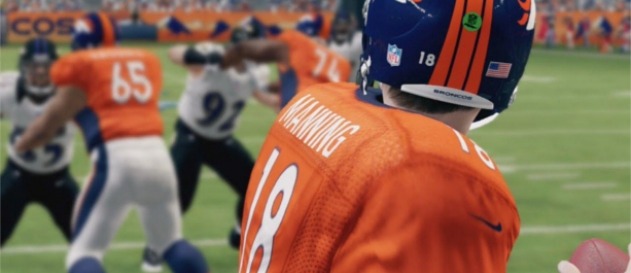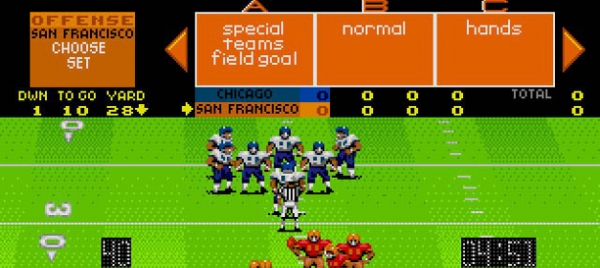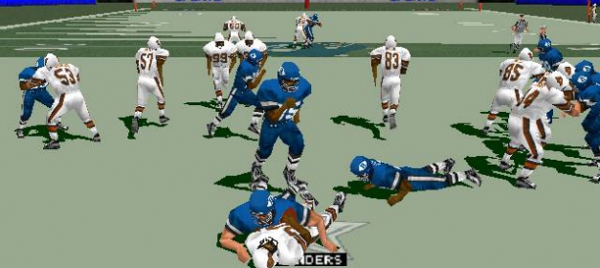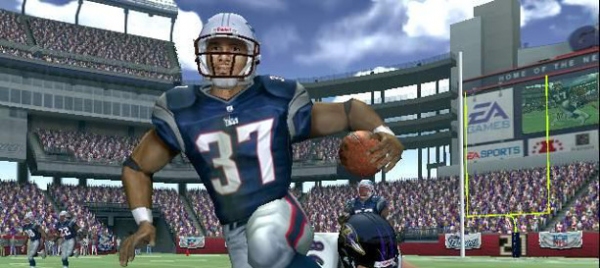
While there’s likely a big budget glossy studio spectacle with a scientist or robot or alien opening in a theater somewhere in America this weekend, who’s going out to the movies with Super Bowl Sunday looming?
Museum of the Moving Image has clearly thought ahead: a few weeks ago they opened a new exhibit entitled Madden NFL: 25 Years and Running. The show traces the evolution of the popular sports gaming franchises from its humble origins in 1988 on the Apple II through to today’s supercharged PS4/Xbox One iteration Madden NFL 25.
Sloan Science and Film talked with guest curator Samit Sarkar from Polygon about the show, the science behind football games and his predictions for Super Bowl XLVIII.
Sloan Science and Film: Tell me about the genesis of the exhibit.
Samit Sarkar: Museum of the Moving Image is on the Super Bowl Host Committee, so they wanted to attract people who are in town for the Super Bowl. 2013 happened to be the 25th anniversary of the Madden NFL franchise, so it seemed like the perfect opportunity to put something together.
SSF: The physical space of the exhibit is quite unique. Can you describe the layout for people who may not get the chance to visit the Museum?
SS: The exhibit is located in the Nam June Paik Room / HBO Production Lab on the third floor of the Museum. Along one wall, there's a big board with the title of the exhibit and a few hundred words of introductory text, along with the game boxes for the five games being highlighted in the exhibit. The next wall has the first four of those games playable on their original hardware and displays (computer monitor, then CRTs). That's John Madden Football (1988) on an Apple IIGS, Madden NFL 94 (1993) on a Genesis, Madden NFL 99 on a PlayStation, and Madden NFL 2005 (2004) on an Xbox. The next wall has a big projection screen with the focal point of the room, Madden NFL 25 (2013) on an Xbox One. And the last wall features a timeline with blurbs for all the games from 1988 through 2013, including footage for each game projected onto the wall above the timeline.

SSF: Looking at the different iterations of the game on display, it's clear that it has made seismic leaps and bounds in terms of presenting a realistic experience to the player. Two part question: Can you talk a little bit about the underlying technology that's allowed for this, and is there a "break" in the series where one game made a huge leap on this score over the previous iteration?
SS: The ability of Madden's developers to produce a realistic simulation of football is tied just as much to the console hardware they're developing on as it is to their own ingenuity and creativity. Graphics are the most notable distinction of increased power, so you usually see the biggest leaps between years when Madden makes the leap to a new console. For example, we included Madden NFL 99 partly because it was the first Madden game in full polygonal 3D, but when Madden NFL 2001 launched with the PlayStation 2 two years later, it its visual fidelity blew people's minds. And even in 2013, where Madden 25 on PlayStation 4 and Xbox One doesn't look leaps and bounds better than it does on PlayStation 3 and Xbox 360, the vast increases in power provided by the new consoles allowed the developers to deliver significant under-the-hood improvements to elements like physics and AI.
SSF: The most recent Madden, especially, seems to have taken realism to an incredible degree, especially in terms of employing the looks and mannerisms of actual players. How do they go about creating that effect?
SS: Madden's developers--and developers of all kinds of games, even outside of sports --rely on a technique known as motion capture for their animations. NFL players don't participate in the motion-capture process because, well, it's pretty grueling. EA mostly uses former football players. (For much more detail, check out this recent NYT article.) Those captured animations are combined with a real-time physics engine that calculates collisions by taking into account factors like the players' size, speed, and direction.

SSF: How much real physics is there running these games?
SS: The developers put a lot of work into trying to make all the objects in the game behave according to the laws of physics. They've been known to spend hours just dropping a football from various heights and in different ways in order to see how it bounces and rolls so they can then program that behavior into the game.
SSF: Further to the previous question, in looking back on the earliest Madden games, because of the more limited gameplay options available at the time, they feel more like strategy than sports games--you pick a play, the other team picks a play and you see what happens. It feels like there has been an increasing amount of emphasis put on the game player to make plays happen after the snap as the series has progressed. Is that a decent assessment in your eyes? And how has the gameplay experience changed over time?
SS: I don't know if I'd agree with that completely. The thing is, football is an 11-on-11 game. But in a video game, you're only controlling one person at a time (the ball carrier, in almost all cases). That's why the AI is so crucial--all the other players on the field (21 in a single-player game) have to look like they know what they're doing, like they're playing football. Whether that's a running back picking up a blitzing linebacker or a safety coming over to provide help on a deep ball, all the players need AI that makes sense for their individual positions and roles (which can change from play to play). If you snap the ball in Madden these days, you'll be amazed by how much of the action is automated, by how much happens without you having to do a thing. And the developers have also been pretty good about adding assists over the years to make the game easier to play for newcomers and casual players.

SSF: Even though each new iteration seems like it presents obvious advances on its predecessors, which do you think is the most fun of the bunch to play?
SS: Right now, the best-playing one is indeed the latest one: the PS4/Xbox One version of Madden 25. As I mentioned above, the advances made possible by the new hardware--blocking AI and player-movement physics chief among them--really make a palpable difference in how the game feels. Because sports games like this are released every year, and they're almost always better than the year before (if slightly), it's hard to assess their quality except in the context of their own time. But my favorite Madden game might be Madden 2005--it was just a great version (again, for its time), with a focus on defense that brought balance back to the series and a fine-tuned experience that was a peak for the games before the high-definition console era began in 2005.
SSF: Any Super Bowl predictions?
SS: I'm a Giants fan, but in this case, I'm rooting for Peyton because I think it's kind of silly that one of the top five quarterbacks in NFL history has half as many Lombardi Trophies as his brother. Broncos by 3.
Madden NFL: 25 Years and Running is up through February 23rd. Click here for more information.
TOPICS